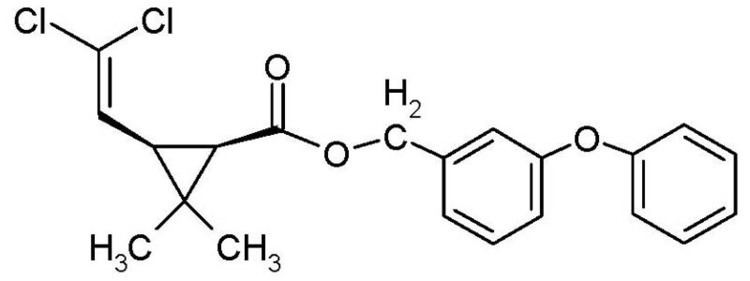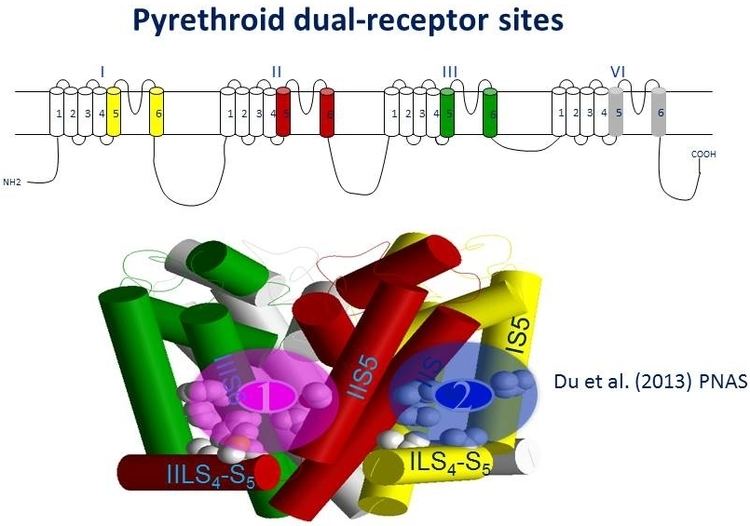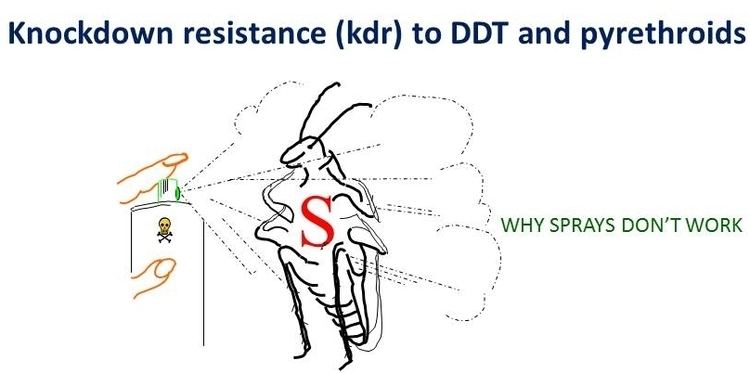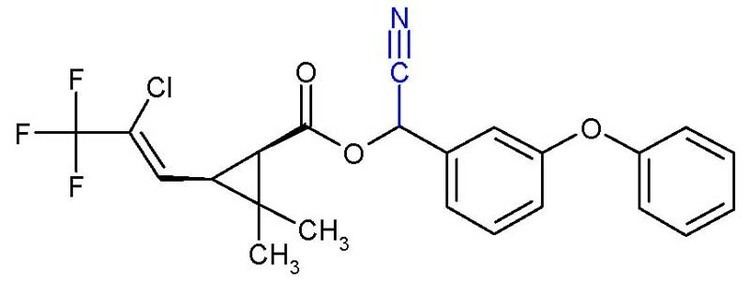 | ||
A pyrethroid is an organic compound similar to the natural pyrethrins produced by the flowers of pyrethrums (Chrysanthemum cinerariaefolium and C. coccineum). Pyrethroids now constitute the majority of commercial household insecticides. In the concentrations used in such products, they may also have insect repellent properties and are generally harmless to human beings in low doses but can harm sensitive individuals however they are known to be toxic to aquatic organisms including fish They are usually broken apart by sunlight and the atmosphere in one or two days, however when associated with sediment they can persist for some time and contribute to toxicity in the surrounding watersheds.
Contents
- Mode of action
- Pesticide formulation
- History
- Classes of pyrethroids
- Environmental effects
- Safety and effectiveness
- Resistance
- References

Mode of action

Pyrethroids are axonic excitoxins, the toxic effects of which are mediated through preventing the closure of the voltage-gated sodium channels in the axonal membranes. The sodium channel is a membrane protein with a hydrophilic interior. This interior is a tiny hole which is shaped precisely to strip away the partially charged water molecules from a sodium ion and create a favorable way for sodium ions to pass through the membrane, enter the axon, and propagate an action potential. When the toxin keeps the channels in their open state, the nerves cannot repolarize, leaving the axonal membrane permanently depolarized, thereby paralyzing the organism.
Pesticide formulation

Pyrethroids can be combined with the synergist piperonyl butoxide, a known inhibitor of key microsomal cytochrome P450 enzymes from metabolizing the pyrethroid, which increases its efficacy (lethality).
History

Pyrethroids were introduced by a team of Rothamsted Research scientists following the elucidation of the structures of pyrethrin I and II by Hermann Staudinger and Leopold Ružička in the 1920s. The pyrethroids represented a major advancement in the chemistry that would synthesize the analog of the natural version found in pyrethrum. Its insecticidal activity has relatively low mammalian toxicity and an unusually fast biodegradation. Their development coincided with the identification of problems with DDT use. Their work consisted firstly of identifying the most active components of pyrethrum, extracted from East African chrysanthemum flowers and long known to have insecticidal properties. Pyrethrum rapidly knocks down flying insects but has negligible persistence — which is good for the environment but gives poor efficacy when applied in the field. Pyrethroids are essentially chemically stabilized forms of natural pyrethrum and belong to IRAC MoA group 3 (they interfere with sodium transport in insect nerve cells).

The first-generation pyrethroids, developed in the 1960s, include bioallethrin, tetramethrin, resmethrin and bioresmethrin. They are more active than the natural pyrethrum but are unstable in sunlight. Activity of pyrethrum and 1st-generation pyrethroids is often enhanced by addition of the synergist piperonyl butoxide (which itself has some insecticidal activity). With the 91/414/EEC review, many 1st-generation compounds have not been included on Annex 1, probably because the market is simply not big enough to warrant the costs of re-registration (rather than any special concerns about safety).

By 1974, the Rothamsted team had discovered a second generation of more persistent compounds notably: permethrin, cypermethrin and deltamethrin. They are substantially more resistant to degradation by light and air, thus making them suitable for use in agriculture, but they have significantly higher mammalian toxicities. Over the subsequent decades these derivatives were followed with other proprietary compounds such as fenvalerate, lambda-cyhalothrin and beta-cyfluthrin. Most patents have now expired, making these compounds cheap and therefore popular (although permethrin and fenvalerate have not been re-registered under the 91/414/EEC process). One of the less desirable characteristics, especially of 2nd-generation pyrethroids is that they can be an irritant to the skin and eyes, so special formulations such as capsule suspensions (CS) have been developed.
Classes of pyrethroids

The earliest pyrethoids are related to pyrethrin I and II by changing the alcohol group of the ester of chrysanthemic acid. This relatively modest change can lead to substantially altered activities. For example, the 5-benzyl-3-furanyl ester called resmethrin is only weakly toxic to mammals (LD50 (rat, oral) = 2,000 mg/kg) but is 20–50 times more effective than natural pyrethrum and is also readily biodegraded. Other commercially important esters include tetramethrin, allethrin, phenothrin, barthrin, dimethrin, and bioresmethrin. Another family of pyrethroids have altered acid fragment together with altered alcohol components. These require more elaborate organic synthesis. Members of this extensive class include the dichlorovinyl and dibromovinyl derivatives. Still others are tefluthrin, fenpropathrin, and bioethanomethrin.
Environmental effects
Pyrethroids are toxic to beneficial insects such as bees and dragonflies, and to fish and other aquatic organisms. At extremely small levels, such as 4 parts per trillion, pyrethroids are lethal to mayflies, gadflies, and invertebrates that constitute the base of many aquatic and terrestrial food webs.
Pyrethroids are unaffected by conventional secondary treatment systems at municipal wastewater treatment facilities. They appear in the effluent, usually at levels lethal to invertebrates.
Safety and effectiveness
Earlier studies suggested that most vertebrates have sufficient enzymes for rapid breakdown of pyrethroids, except for cats. Pyrethroids are highly toxic to cats because they do not have glucuronidase, which participates in hepatic detoxifying metabolism pathways.
A recent study, however, suggests that developing mice exposed to deltamethrin (a pyrethroid pesticide) show neurological and behavioral changes resembling Attention-Deficit/Hyperactivity Disorder (ADHD) in humans. In terms of LD50 for rats, Tefluthrin is the most toxic at 29 mg/kg. Anaphylaxis has been reported after pyrethrum exposure, but allergic reaction to pyrethroids has not been documented. Increased sensitivity occurs following repeated exposure to cyanide, which is found in pyrethroids like beta-cyfluthrin (Multiple Chemical Sensitivity Awareness, J. Edward Hill, MD, President & Executive Committee Member, AMA).
Resistance
Although bedbugs were almost eradicated in the North America through the use of DDT and organophosphates, populations of bedbugs resistant to both have developed. The use of DDT for this purpose was banned, and its reintroduction would not offer a solution to the problem of bedbugs, due to resistance. Pyrethroids became more commonly used against bedbugs, but resistant populations have now developed to this as well.
